It’s been about a week since Pokemon Sun and Moon have been released for the 3DS. And boy have they done well in that time frame. They’ve scored 87% on Metacritic. Boosted 3DS sales in all regions by a significant level. Heck, they’ve even managed to become Nintendo’s biggest ever UK launch successes, with their sales in the first two days being higher than Wii Fit’s in its first two WEEKS.
But how good are these games really? Are they better than the previous Pokemon titles in the series? Can they make Pokemon X and Y look like crap by comparison? Will they inspire Pokemon GO players to try out the full titles?
Well, let’s find out for ourselves, in our exclusive review of Pokemon Sun and Moon for the 3DS!
Graphics
So let’s start out with the graphics. How good are they in this title?
Pretty fantastic actually. Seriously, look at this and tell me it doesn’t look a million times better than the games you used to play on the original Game Boy:

Heck, it even puts the recent 3DS Pokemon games to shame too! X and Y? Omega Ruby/Alpha Sapphire? God, those look almost prehistoric by comparison.
And there are a few reasons for this.
For one thing, note the camera is a lot ‘lower’ in these games. Whereas old Pokemon games had a top down view, these ones have the camera pointing downwards on a slant behind the main character instead. This change in perspective makes the world look much more three dimensional than the past titles, as well as less like a series of grids pasted together.
There’s also the more realistic art style in general. I mean yeah, the Pokemon have traditional designs, sure. But the people themselves look more like normal humans rather chibi dolls/Game Boy sprites, and the environments look like 3D places with rounded edges and curved paths rather than a bland series of grids. This in turn makes things look more lifelike than it did before, and the Alola region feel like a real place with normal looking humans.
And the small background details help too. Like say, the trainers actually sticking around in battles to give orders to their Pokemon!
Yep, you heard me right. Now when you battle an opponent, both you and the other trainer are visible at all times. You even see them give orders to their Pokemon in regards to what attacks they should use when fighting!
It’s only a minor touch, but it helps make the games a great deal more immersive, and removes the awkward separation between the overworld and trainer battles that the older games had.
Which in itself seems to be a goal with Pokemon Sun and Moon. They’re trying to remove the ‘gap’ between what the game says is happening and what’s being shown on screen. For example, Ride Pokemon (more on that later in the review) are actually shown pushing blocks, flying or surfing on water instead of it being implied by a simple animation. Trainers don’t always stand still on the map, instead often walking or swimming around to look for opponents. And while most Pokemon encounters are still in tall grass, that’s not the only way they’re presented here.
Oh no, you can sometimes get ambushed by Pokemon flying above (complete with shadows underneath), them visibly moving in the grass (as a black shadow that homes in on your location) or even doing things like jumping out of trees or berries when you least expect it.
Yeah, they’re all minor things in the bigger picture, but they make the world look a whole lot more ‘alive’ than it did previously.
Unfortunately, all this detail comes at a price.
Namely, the games run terribly on a normal 3DS. Think I’m exaggerating? Well, here’s a comparison between the same games on a normal 3DS and a New Nintendo 3DS:

As you can see, it takes about 10 seconds longer to even boot the game on the older system. You have to wait for the system to reboot to quit out of the game and shut down.
And that’s still not the worst of it. Oh no, that ‘honour’ goes to the game’s performance in double and totem battles. There, the frame rate literally drops in half immediately. Like, to the point it’s sometimes in the single digits. Where animations outright freeze for a few seconds while the game tries to keep up.
That’s unacceptable for a 3DS title like this. I mean yeah, it’d make sense for a complex 3D title with hundreds of things on screen (like Luigi’s Mansion 2 with its Paranormal Chaos mission), but not here. Pokemon Sun and Moon look nice, but there’s nothing there that really should be straining the 3DS this much.
So yeah, it’s good as far as graphics go, but perhaps one best played on a New Nintendo 3DS given the crippling technical faults that come up on older hardware. But how does that soundtrack hold up here?
Music
Well, it holds up really well to be honest. Because damn, Pokemon Sun and Moon has a great soundtrack.
Now admittedly, that’s not exactly too unexpected by this point. After all, every single Nintendo game on the 3DS in the last five years or so has sounded incredible, as have most of their titles on the Wii U. It’s like the 2000s and 2010s are Nintendo’s glory years as far as video game music is concerned.
But even with all the fantastic competition, Pokemon Sun and Moon’s soundtrack is one to remember. You’ve got all those catchy area and town themes, which perfectly fit the mood of a tropical vacation:


As well as the numerous catchy battle themes:



And many more besides. Of special note are the themes for the two villain groups of the game (Team Skull and the secret other team):



Which in the case of the former, are… ‘interesting’ attempts at hip hop music with a Pokemon flavour to it. The latter? Well, yeah, just hear for yourself:

Oh, you didn’t think the Aether Foundation were evil? Well, there’s not really much point hiding it now. After all, the game kind of hints at them being evil all of five seconds into the opening cutscene and practically the entire internet had figured it out long before the games were released.
And hey, they’ve got some catchy songs, so that’s something to consider too. Either way, it’s a good soundtrack, and one that’s actually quite epic for the series it’s being used in.
However, does the gameplay itself stack up?
Gameplay
Cause at the end of the day, even the nicest graphics and music would be irrelevant if the gameplay was poorly done.
Fortunately though, Pokemon Sun and Moon is still as fun to play as any other game in the series. The battle system is solid, with the setup being mostly identical to that in X and Y. The basics of the overworld design are still as great as they always were, with interesting places to explore, items to find and Pokemon to encounter in the tall grass. And there’s the obligatory online system that lets you fight or trade with others from all round the world.
Yet as good as the normal mechanics are, they’re not really why Sun and Moon shine. After all, X and Y were seen by many people by rather disappointing, yet they nailed the battle system and overworld exploration just fine.
Oh no, it’s the new stuff that’s really interesting in Sun and Moon.
Like the Z-Moves. These are super powerful Pokemon moves with flashy effects that can be used once per battle. Like this:

As you can guess, these are usually a one hit kill on whatever doesn’t resist them. Or in the case of the status move variants, a massive boost in power to the point a single Pokemon can clear out whole teams.
And this adds a decent amount more strategy to the battles than you’d expect. Why? Because you never know how the opponent will set them up. They might go for one right off the bat, aiming for a quick KO at the expense of leaving the team vulnerable later. They might save them, as a last ditch trump card to change the tide of battle. Or they might just bring ‘em out to take down a certain Pokemon on your team, like a ‘wall-breaker’ in the competitive scene.
It’s a neat battle mechanic, and adds a surprising amount of depth to the system. But the game’s features get more interesting still.
Like say, the new movement system. Remember how in past games, you had to walk in straight lines?
Well that’s gone now. You can simply walk wherever you like, similar to in a 2D Zelda game. So yeah, basic movement now feels a lot more fluid than before, with the awkward tank controls being a thing of the past.
But that’s not the only old school system getting an overhaul.
Oh no, the gyms are too.
Why?
Because this game has no gyms at all! The whole system has been ripped out, gym leaders, badges and all.
In their place, you get the Island Challenge. What’s this? Well to put it simply, you travel around solving ‘trials’ to become a better trainer. To some degree, these trials are structured a bit like gyms. You’ve got a trial captain leading them, complete with a unique personality and design similar to a gym leader. There’s a special totem Pokemon you fight at the end, with boosted stats (which kind of acts like the gym leader battle from earlier games). And beating them gives you certain Z-Moves and items, like how beating gyms gave you badges and TMs in previous titles.

Heck, you even have another boss after all trials on an island are done. This is a fight with the ‘kahuna’ (ruler) of the island, who acts like an even tougher gym leader analogue.
But here’s the thing:
Island trials are not combat focused. Instead, the actual task varies significantly based on who’s running it and what their interests are. So you’ll be exploring a jungle looking for cooking ingredients, watching dance moves from a trio of Marowaks, completing an audio quiz to lure the totem Pokemon to your destination… and much more besides that. It’s a nice change of pace to the otherwise stale gym formula that’s remained a fixture for the first 6 generations.
That said, island trials aren’t the only change the series has received with Sun and Moon.
Oh no. There are also no HMs (Hidden Machines) in Pokemon Sun and Moon.
Instead, we get a system called the Poke Ride. This lets you register special Pokemon for moving around the overworld and solving puzzles, like a Lapras to surf on or a Charizard to fly between areas.
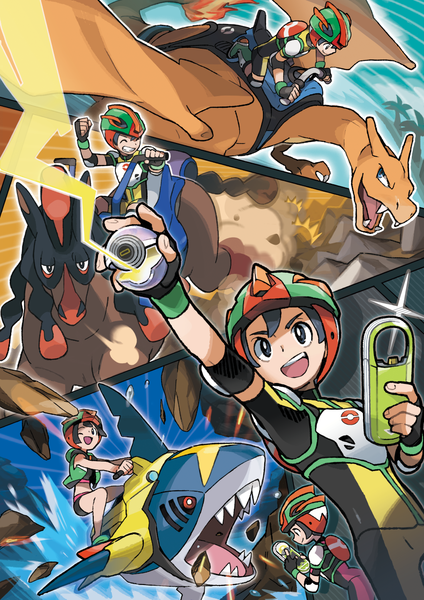
And it makes the game far, far much more enjoyable to play than the old system ever did.
Why? Because for one thing, you don’t end up with a limited team because of it. I mean, think about what you needed to have to get around the old regions. A flying type to use Fly, a water type to use moves like Surf, Waterfall, Whirlpool and Dive, a bulky physically orientated Pokemon for strength… basically, your options were limited by the HMs you had to use.
Want an all fire type team? Tough luck kiddo, you need something that cross the ocean or go underwater. Don’t like birds? Eh, you can only usually teach Fly to them or certain dragons. So you were seriously limited there too.
Now in theory, a lot of players found another way to solve this. They called it a ‘HM slave’, where some mostly useless Pokemon would be given the task of solving overworld puzzles in order to spare the rest of the team from having the movesets wrecked. But it was one step forward and two steps back really; the extra Pokemon would be nothing more than on a millstone you had to put up with simply to get around. As well as a liability if you ever got into a battle and ran out of other useful Pokemon (since most ‘HM slaves’ are useless in combat). Add the obvious awkward implications (you’re using a Pokemon as a simple tool rather than a companion), and again, it didn’t really work.
But with Poke Ride, all this is now gone. No worrying about losing attack slots to worthless HM moves. No limits on who can choose for your team. Basically, it’s Pokemon the way people wanted to play it all along, a system without unnecessary compromises and other bullshit.
It gets better too. You know all those puzzles you had to solve on the overworld with these HMs?
Well, most of those are gone too. You don’t have to cut any trees down, there are no caves to light up or remove fog from. No rocks to smash in the middle of routes. Heck, even the stuff that does remain here (like pushing boulders) is drastically simplified from the olden days.
This makes for a world that’s altogether less of a chore to navigate, and feels like it isn’t wasting your time with pointless filler content.
And that’s a key strength of Pokemon Sun and Moon in general. The game doesn’t waste your time any more. Instead, you’ve got a game that’s been simplified and fixed as to be playable by people with a lack of free time.
For example, now you:
- Don’t have to use a PC to take out a newly caught Pokemon. You can just swap it into your party the moment you catch it.
- Only watch the credits once after beating the champion, with future playthroughs just putting you outside the Pokemon League instead of playing all those long cutscenes again.
- Can use multiple copies of a single item in a row, by just clicking on Pokemon names in a list multiple times.
- Can use Poke Balls in battle by pressing a single button to open the right pocket, rather than scrolling through a big list of irrelevant items.
- Set up EXP Share so every Pokemon in the party gets full experience for any battle.
- Increase a Pokemon’s EVs and IVs without endless breeding or battles.
- And heck, even get more EXP for catching Pokemon now too! So someone filling out the Pokedex isn’t being penalised for simply focusing on their collection rather than trainer fights.
In other words, it’s a more convenient Pokemon game. One that’s actually going to be enjoyable for the Pokemon GO generation.
And that’s a great thing. Old school Pokemon wasn’t bad, it was just very, very time consuming. The UI just made everything feel as drawn out as possible.
Pokemon Sun and Moon fixes that, and is a thousand times better for it.
However, the biggest change/improvement in these games isn’t about ride Pokemon or trials. No, it’s about the story and general tone.
Because as you can see from the thousands of articles about it online, the games have took a rather… dark turn with Pokemon Sun and Moon.
Seriously. Imagine if I said there was a new game that had abusive parents, eldritch abominations, mind control, the end of the world, kids being kidnapped, gangs taking over cities and a conspiracy involving an ‘animal rights’ group being a terrorism front. You’d probably think I was talking about an ‘adult’ RPG on the PlayStation or Xbox. It’s certainly a far cry from what you’d see in Pokemon, right?
Well no. That’s basically the story outline for Pokemon Sun and Moon. It gets absolutely and utterly insane sure, but that’s pretty much how the story goes here. Heck, just walking through Po Town or Aether Paradise makes you think ‘this is a Pokemon game?’ in just how jarringly different the locations are from the norm.
And this darker storyline is always there, front and centre. For example, the entirety of the game’s third island onwards is dedicated to the storyline. You’ve got the Aether House, where it turns out the Team Skull admins have stolen a preschooler’s pet and have take it away to their base. Their whole base of operations in Po Town, which looks like a war zone filled with barricades, broken down houses, grunts standing on vehicles complete with the team leader’s wrecked and heavily fortified mansion at the end of the street. And that’s only the beginning!
Basically, it’s a bit of a crazy thrill ride that emphasises the evil team’s plans over the typical ‘get better and become the champion’ element, and it works wonderfully for.
Of course, it also helps here that the characters have some semblance of a personality this time around. After all, does anyone remember who the rivals were in generation 3 onwards? No?
Me neither. Because they didn’t do anything. They showed up every so often, gave you a few words or a quick battle and then kind of fell by the wayside when the endgame started.
They were cardboard cut-outs that completely failed to give you a reason to care about them.
That’s not the case here. Oh no, now the rivals and friend characters (in this case Hau, Gladion and Lillie) actually have goals throughout the game and pop up on a regular basis as you’re exploring the region. They complete trials, try out the activities in various towns and cities, challenge you to battles every few hours or so (at least the first two). Heck, the former two guys even go as far to support you when raiding the supervillain lair the main antagonists operate out of, trying to fight bad guys and supporting you in double battles all the while.
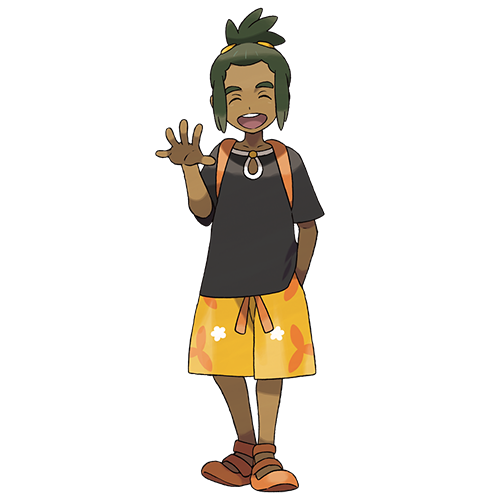
And this characterisation isn’t just limited to your close friends and rivals. Oh no. Professor Kukui shows up fairly often whenever the plot requires for it, and has a far deeper connection to the Pokemon League that any professor before him. The kahunas and trial captains actually do things outside of standing around in their home towns and waiting for challengers (like say, taking on legendary Pokemon that appear from nowhere or visiting each other’s trials to see how things and going.
Heck, even the villains are generally interesting personality with actual characterisation this time around. Lusamine has a lot of secrets that are extremely important to the storyline (though giving them away would be spoil about half the plot), the Team Skull grunts actually have an excuse for their evil ways (coming from broken homes and failing in life before joining as a last resort), and even their blatantly evil leader Guzma has an excuse (of sorts) for his own selfishness and poor behaviour throughout the game.
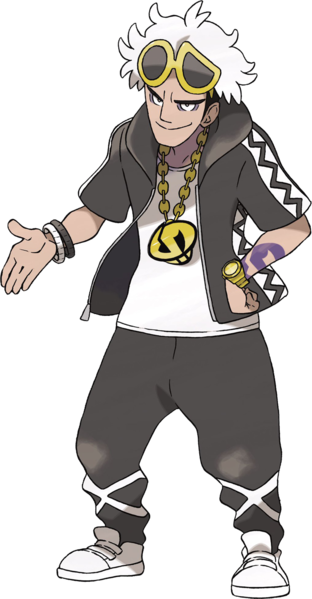
Basically, it makes you want to succeed. To go on an adventure with people you almost consider as friends.
That said, there are still a few issues here. Most notably?
The linearity and restrictions on where you can go at any time.
Because like a lot of Nintendo games in recent years (Mario & Luigi Dream Team, most Zelda games before A Link Between Worlds and Luigi’s Mansion Dark Moon), Pokemon Sun and Moon just loves to throw tutorials and dialogue and mandatory events in your face every six seconds. Arrived at a new city? Well, time to meet up with the rival and Lillie and the professor and whoever else to talk about whatever the heck’s supposed to happen next.
Just completed a trial? Well then, the very next area you need to go will open up as if by magic. Oh, you didn’t want to go there?
Well, tough luck kid. There’s an angry Tauros blocking the path. Or wet paint on the gate. Or a literal roadblock across half the route, complete with a trial helper saying ‘you have to have beaten the last trial to pass this barricade’.
Now, I know what you’re gonna say. Isn’t this like the rest of the series?
Well, kind of. Yeah, you need to get the flute to wake up Snorlax, beat the Pewter City gym to get that annoying kid out of the way and buy some lemonade to have the Saffron City guards let you in. To some degree, Pokemon games have always been a fairly poorly disguised sequence of linear events that try and filter you down the ‘most convenient’ path from the home town to the Elite Four. I get it.
But it’s just ridiculous in these games. It’s like they’re not even trying to hide how linear the games out, almost to the point of self parody. Heck, you’ve even got a little flag icon marking your next location, in case you somehow missed the hint that ‘suddenly open side area’ is the next stop on your storyline tour of the Alola region.
It also doesn’t help that your movement (while fully 3D) is still really limited in these games. Want to drop down off a ledge? Tough luck kid, find a ramp or something. Is that slope anything less than perfect? Then you’re not climbing up it, regardless of how much you try. Small obstacle (like a picket fence) in your path? Well, looks like you’re not going this route today.
It gets very annoying on Poni Island, where the canyon areas are filled with shortcuts you should easily be able to take (assuming your thirteen year old avatar is in good shape) but somehow can’t for technical reasons. Or in the Shady House, where the only reason you need to find three passwords to reach Guzma is because someone left an anchor on the set of stairs that bypasses the blocked door.
Outside of path progression linearity issues, Pokemon Sun and Moon also have a few minor flaws that hinder the experience somewhat. Such as how some Pokemon are severely limited in when they can evolve.
What do I mean by this? Well, here’s Charjabug, along with Vikavolt. How do you think the former evolves into the latter?
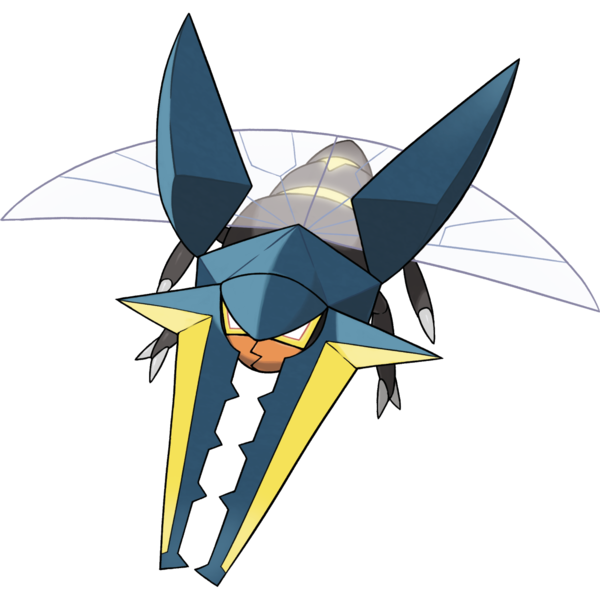
Through levelling up, an evolutionary stone or trading, right?
Wrong! It has to level up in a certain area. That area? Great Poni Canyon.
But here’s the issue; Great Poni Canyon is on an island called Poni. This is the last area in the game you visit.
Meanwhile, Charjabug and its pre evolution are found on the first island.
See an issue here? Yeah, it’ll take you about 20 hours to get from the point you find some of these Pokemon to the point you can actually evolve them. And it’s not just limited to this family too. Magneton only evolves in Magnezone in Great Poni Canyon too. Again, about 20 hours of using an underpowered 1st evolution is needed before you can actually evolve it.
And yet it’s still nothing compared to Crabrawler and its evolved form. Why? Because you have to level him up in an area with SNOW.
Guess where the only area with snow is?
Victory Road. You know, the area right before the final boss. Keeping in mind the first form is found on the first island, that means you’ll have to keep a fairly weak Pokemon in your team for 30 whole hours before you can get something that’s moderately decent out of it.
Yeah, it’s a minor annoyance I know. But it’s still an annoyance that will affect a fair few players, and one I should point out now rather than never.
Either way, Pokemon Sun and Moon are generally great games overall. Perhaps a tad linear for a few, but still great in the gameplay department none the less.
Game Length/Replay Value
So now we know Pokemon Sun and Moon are good games, how long do they last? What’s the replay value like here in general?
Well for the former, my playtime clocks in it at about 20 hours from the intro to the final boss. So if you’re after a typical playthrough, you’re gonna get something roughly on par with the Mario & Luigi or Paper Mario franchise; not that long of an experience, but enough that it feels you’ve gotten your money’s worth.
However, here’s the key:
My playthrough, was done as quickly as possible in order to get my thoughts out sooner rather than later. I stuck with a single team through most of the game, avoided catching Pokemon I thought weren’t necessary, didn’t try many of the extra features and spent no time at all fighting people over wifi.
If you actually do those things?
Like, actually try out everything there is to do in this game?
Then trust me, your playthrough will take about twice the amount of time my one did. And that’s not all.
Oh no, you need to keep in mind that I’m also someone who’s played earlier games in the series. Someone who for the most part, is a bit of an expert at completing video games as quickly as possible.
And even then, it wasn’t as easy as I thought it’d be. Yes, the EXP Share removes some of the difficulty. It has to, the item/option is overpowered as all hell and has been since generation 6. Yes, the starters seem to be a bit more competitively viable than they were in the early generations. That all helps a tad.
But the trainers also often have an actual strategy in mind here. They’ll use status moves to waste your time while setting up their stat boosts. Moves that aggravate half the tournament scene (like Stealth Rock) are used by the elite four and champion to surprisingly decent effect. And heck, even the wild Pokemon can be moderately smart when they need to be.
Like say, the Tapu Guardians. These Pokemon are smart enough to realise that using Nature’s Madness (a move which always takes off exactly 50% of an enemy’s current health) is a good choice right after you heal with a Full Restore or Potion.
Or the totem Pokemon in general, who’s summoned help will either be good against its weakness, heal it on a regular basis or boost the power of its attacks through their ability.
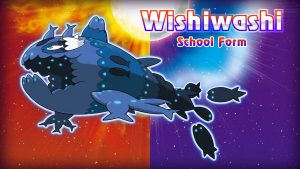
So the difficulty has increased quite significantly over previous titles, likely adding another ten or so hours to playtime due to the mistakes you might be making in plot significant battles.
And that’s just the beginning. Why? Because like in every other game in the series, there is a significant amount of things to do after the final boss. These include:
- An Ultra Beast hunting quest where you have to track down five species of dangerous extradimensional Pokemon on orders of the international police. This is surprisingly difficult, given the trainer battles necessary before every mission and the ability of the beasts in question.
- The whole of Poni Gauntlet, which acts like a pseudo gym to an island trial captain you never face in the main story.
- A hundred different Zygarde cores you have to collect across the game to assemble a certain powerful legendary Pokemon. Some of these are only found in the day or at night, so good luck finding them.
- A whole plethora of bonus bosses, including a Game Freak employee, a rematch with the Team Skull leader and various trainers that only appear after you beat the game for the first time.
Along with the numerous online features, the Poke Finder (read, Pokemon Snap as a mini game), QR code scanning for rare Pokemon and the usual Pokedex of about 300 to capture in this region alone. Either way, you will never run out of things to do, with Pokemon Sun and Moon basically offering infinite replay value.
Conclusion
Pokemon Sun and Moon are great games, and make for fine additions to the Pokemon series. They’re not perfect (especially in regards to linearity and technical issues on older 3DS models), but they’re definitely worth buying if you’re a fan of Nintendo, Pokemon or RPGs in general.